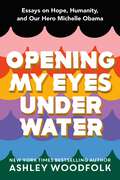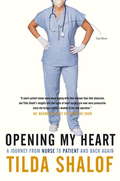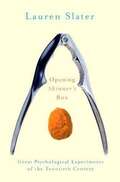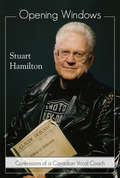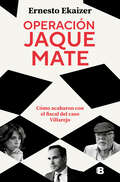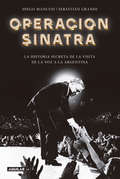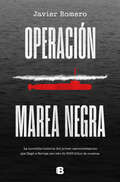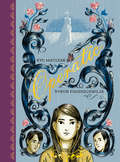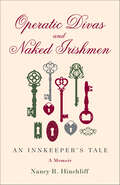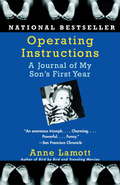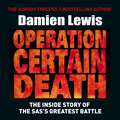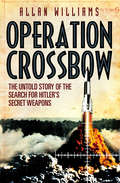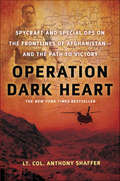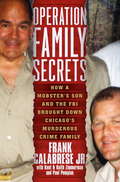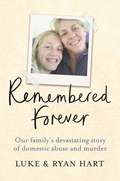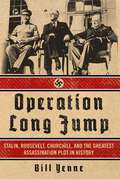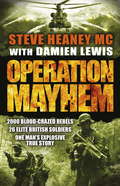- Table View
- List View
Opening My Eyes Underwater: Essays on Hope, Humanity, and Our Hero Michelle Obama
by Ashley WoodfolkInspired by the life and quotations of former first lady Michelle Obama, Opening My Eyes Underwater is a collection of essays penned by bestselling author Ashley Woodfolk. Essays of bullying, heartbreak, racism, and confidence, Ashley taps into her own past and shares those stories that made her who she is today as she seamlessly weaves in parallel experiences that both she and Mrs. Obama have faced in their separate childhoods as well as their adult lives. Open, searing, and honest, these are stories readers will feel seen with. Readers who are growing and learning as they move forward through life's triumphs and pitfalls will undoubtedly gravitate to and find comfort within its pages.
Opening My Heart
by Tilda ShalofTilda Shalof had been taking care of critically ill patients in an intensive care unit for more than twenty-five years, but taking care of herself had never been a priority. That is, until she could no longer ignore her extreme fatigue, shortness of breath, and crushing chest pains. When the results came in, it was time to face the music: Tilda required immediate open-heart surgery to replace a defective valve and to repair damage done to this vital organ. Tilda's story takes readers from the diagnosis through all her fears and concerns, the or, her stay in the icu, the cardiac ward, recovery at home, rehabilitation, and ultimately, her return to work in the hospital armed with new insights on the patient's perspective. She learned more in her week-long stay as a patient than in all her years caring for the critically ill, especially about trust and working in partnership with her caregivers. In Opening My Heart, Shalof expertly weaves recollections from her career and accounts of other nurses' experiences into her own story, creating the perfect marriage between fascinating clinical detail and a personal journey of healing. Throughout it all is Shalof's warm, friendly voice and humorous outlook. Nurses everywhere and anyone who's ever been a hospital patient, or who is currently hospitalized or who might be one day (and those who love them!), will be empowered, enlightened, comforted, and entertained by this book.From the Hardcover edition.
Opening Skinner's Box: Great Psychological Experiments of the Twentieth Century
by Lauren SlaterThrough examples of experiments by some of psychology's innovative thinkers, Slater traces the evolution of the century's most pressing concerns-free will, authoritarianism, conformity, morality.
Opening Weekend: An Insider's Look at Marketing Hollywood's Hits and Flops
by Jim FredrickIn a world where movie marketers are the stars of the story, Opening Weekend: An Insider's Look at Marketing Hollywood's Hits and Flops recounts Jim Fredrick’s journey through the realm of movie marketing. Fredrick offers readers exclusive access to behind-the-scenes anecdotes and firsthand accounts of working with studio executives and navigating relationships with famous movie stars and directors.After starting his career in 1983 as a trailer editor and producer at famed advertising boutique Intralink, Jim Fredrick went on to serve as president of marketing at Castle Rock Entertainment; senior vice president of creative advertising at Warner Bros.; and executive vice president of marketing at Sony Screen Gems. In 2011, he founded his own company, Jim Fredrick Motion Picture Marketing. Across a span of thirty-five years, Fredrick’s roles as a trailer maker and studio executive allowed him to craft advertising campaigns for a range of movies, from such iconic cinematic gems as The Shawshank Redemption to the widely beloved Harry Potter franchise, to commercial failures like The Adventures of Pluto Nash and Fired Up! Opening Weekend explores the intricacies of the lesser-known business of film distribution and marketing, unraveling the complex mechanisms through which movies are sold to discriminating audiences. Replete with triumphs, setbacks, and the relentless spirit that drives the creation and promotion of cinematic masterpieces, Opening Weekend promises an enthralling glimpse into the previously untold world of Hollywood movies.
Opening Windows: Confessions of a Canadian Vocal Coach
by Stuart Hamilton Lotfi MansouriA vocal coach who has been in the vanguard of classical music in Canada for more than six decades. Stuart Hamilton is a well-known Canadian musician who has been in the forefront of music in Canada for more than 60 years. Here, in this memoir, he recounts his sometimes hectic assault on the Canadian music world. Along the way, Hamilton encountered, as a vocal coach and accompanist, most of the great Canadian singers of the last half of the 20th century, and some international ones as well. For 27 years Hamilton was an erudite and funny personality on CBC’s Saturday Afternoon at the Opera. He has appeared across Canada with such beloved artists as Lois Marshall, Maureen Forrester, Richard Margison, and Isabel Bayrakdarian. In Opening Windows, Hamilton takes the reader into his confidence on numerous matters that have influenced musical life in Canada for decades.
Operación Jaque Mate: Cómo acabaron con el fiscal del caso Villarejo
by Ernesto EkaizerEl nuevo libro del reconocido periodista Ernesto Ekaizer se adentra en el polémico caso Villarejo y cómo el fiscal Stampa fue apartado por razones políticas. ¿Quién es de verdad el excomisario José Manuel Villarejo, el hombre de las mil identidades? ¿Agente encubierto de inteligencia o CEO del conglomerado de empresas CENYT que ha amasado una fortuna? ¿Cómo y por qué afloran unos audios -32 terabytes o doce tráileres llenos a rebosar de papel— en los cuales Villarejo ha grabado a personalidades de la política, la empresa, la policía y la justicia? ¿Quién es Ignacio Stampa, el fiscal al cual la fiscal general del Estado apartó del caso Villarejo precisamente por su infatigable afán de investigar? Operación Jaque Mate es una nueva prueba de que la realidad supera a menudo la ficción. El lector se adentra en un relato apasionante en que podremos conocer los entresijos de diferentes tramas -el caso Tándem, la operación Kitchen, el caso Iberdrola, BBVA, la Operación Cataluña...- en las que el dinero, la corrupción y el poder son las piezas de una partida en la que el Estado de Derecho -la democracia- es la gran víctima. «No son los subsuelos o cloacas del Estado. Es el Estado convertido en subsuelo o cloaca por orden gubernamental».
Operación Sinatra: La historia secreta de la visita de La Voz a la Argentina
by Diego Mancusi Sebastián GrandiPara muchos, la visita de Frank Sinatra a la Argentina fue un fracaso económico de Palito Ortega, pero él no fue el único responsable del viaje de La Voz al país. También hubo un entramado político entre el gobierno militar, el de Ronald Reagan y la CIA. La historia recuerda a Palito Ortega como el único gestor de la visita de Frank Sinatra a la Argentina. Sin embargo, existió otro protagonista: Ricardo Finkel, quien en esta investigación ofrece su versión de los hechos y cuenta cuál fue el verdadero rol de Palito en el viaje de La Voz al país, más allá de las presentaciones en el Sheraton Hotel y el Luna Park. ¿Cómo fueron las negociaciones? ¿Era Sinatra un agente de la CIA? ¿Trajo un mensaje del presidente Ronald Reagan para el gobierno de facto argentino? ¿Quiénes eran las únicas personas que podían llamar directamente a su habitación? ¿Cómo engañaron los técnicos argentinos a los del cantante? ¿Amalita Fortabat colaboró económicamente? ¿Por qué Palito pidió ayuda al poder de turno? ¿Quiénes participaron en el festival anti-Sinatra? Todo el backstage de una visita que fue mucho más que una serie de recitales del más grande de todos los tiempos. Como dijo David Bowie, "la única razón por la que uno usa la figura de Sinatra para explicar de qué se trata sostener un personaje es que él es, más o menos, la única persona que lo ha conseguido. No es simplemente un actor o un cantante. Trasciende todas las áreas".
Operación marea negra: La increíble historia del primer narcosubmarino que llegó a Europa con más de 3000 kilos de cocaína
by Javier Romero3.068 kg de cocaína. Un excampeón de boxeo que tomó una decisión que le cambió la vida. Un narcosubmarino que llegó a España haciendo realidad la leyenda. Colombia fue el origen, el Amazonas el inicio del viaje, y Galicia el destino improvisado del primer narcosubmarino transoceánico interceptado en Europa. Esta es la historia real de la fascinante travesía de tres hombres que trasladaron a ras de agua más de 3.000 kg de cocaína durante veintiocho días conviviendo entre miseria. Pero también es la historia de Agustín, un excampeón de boxeo que bajó del cuadrilátero para convertirse en el capitán de esta peligrosa misión en la que acabó involucrando a sus amigos de Vigo, que no estaban llamados a ser protagonistas. Operación Marea Negra es la crónica certera y definitiva de estos hechos. Un libro emocionante y exhaustivo en que el periodistaJavier Romero recoge los testimonios exclusivos de policías, jueces, especialistas y testigos de uno de los sucesos más increíbles en la historia del narcotráfico en España.
Operatic
by Kyo MaclearA story of friendship, first crushes, opera and the high drama of middle school told by award-winning Kyo Maclear in her debut graphic novel.Somewhere in the universe, there is the perfect tune for you.It’s almost the end of middle school, and Charlie has to find her perfect song for a music class assignment. But it’s hard for Charlie to concentrate when she can’t stop noticing her classmate Emile, or wondering about Luka, who hasn’t been to school in weeks. Then, the class learns about opera, and Charlie discovers the music of Maria Callas. The more she learns about Maria’s life, the more Charlie admires her passion for singing and her ability to express herself fully through her music. Can Charlie follow the example of the ultimate diva, Maria Callas, when it comes to her own life?Key Text Featuresspeech bubblescaptionsbibliographyCorrelates to the Common Core State Standards in English Language Arts:CCSS.ELA-LITERACY.RL.4.3Describe in depth a character, setting, or event in a story or drama, drawing on specific details in the text (e.g., a character's thoughts, words, or actions).CCSS.ELA-LITERACY.RL.6.3Describe how a particular story's or drama's plot unfolds in a series of episodes as well as how the characters respond or change as the plot moves toward a resolution.CCSS.ELA-LITERACY.RL.6.6Explain how an author develops the point of view of the narrator or speaker in a text.
Operatic Divas and Naked Irishmen: An Innkeeper's Tale
by Nancy R. HinchliffIn 1994, at the age of 64 with no business experience and very little start-up money, Nancy Hinchliff buys a turn-of-the-century mansion in Louisville, Kentucky and turns it into a charming Victorian Inn. Through sheer tenacity, she learns the business while successfully coping with one mishap after another. An admittedly asocial retired school teacher, she reinvents herself as an Inn keeper. The reader is drawn into this humorous and engaging tale as the author wields her way around cantankerous contractors, harrowing housekeepers, and no shortage of strange and interesting guests and events. Through her collected stories, Hinchliff gives readers a personal, in-depth, and honest look at what it’s like to be an inn keeper as she candidly describes her twenty-year journey of self discovery.
Operating Instructions: A Journal of My Son's First Year
by Anne LamottNATIONAL BESTSELLER • The acclaimed author of Bird by Bird brings her brilliant combination of humor and warmth to a "smart, funny, and comforting" chronicle of single motherhood (Los Angeles Times Book Review).It&’s not like she&’s the only woman to ever have a baby. At thirty-five. On her own. But Anne Lamott makes it all fresh in her now-classic account of how she and her son and numerous friends and neighbors and some strangers survived and thrived in that all important first year. From finding out that her baby is a boy (and getting used to the idea) to finding out that her best friend and greatest supporter Pam will die of cancer (and not getting used to that idea), with a generous amount of wit and faith (but very little piousness), Lamott narrates the great and small events that make up a woman&’s life."Lamott is a wonderfully lithe writer .... Anyone who has ever had a hard time facing a perfectly ordinary day will identify." —Chicago Tribune
Operation Bluecoat: Breakout from Normandy (Over the Battlefield)
by Ian DaglishAfter seven weeks of bitter fighting there was a desperate need to break out of the Normandy bridgehead. In late July 1944 Lieutenant-General Sir Miles Dempseys Second Army moved two entire corps from the Caen sector to the relatively quiet countryside around Caumont. Here, the British XXX Corps prepared to give battle, with VII Corps advancing in support on the right flank between XXX Corps and the American first Army. The offensive did not go to plan. While the XXX Corps attack stalled, VIII Corps surged ahead. With the experienced 11th Armoured and 15th Scottish Divisions in the lead and Guards Armoured close behind, a deep penetration was made, threatening to take the pivotal city of Vire and unhinge General Haussers German Seventh Army.The main narrative of this book will span the initial break-in from Caumont on 30 July, through the armored battles of the following days, to the desperate German counter-attacks of 4 6 August, the no less desperate German defense of Estry up to the middle of the month, and the final withdrawal from Normandy. The book also examines Montys refusal to seize Vire, the disputed Anglo-American border and the Operations impact on the German Mortain offensive.
Operation Certain Death: THE INSIDE STORY OF THE SAS’S GREATEST BATTLE
by Damien LewisOperation Certain Death chronicles the story of the single most daring Special Forces operation since World War Two - Operation Barras; the attempted rescue by the SAS of the British Forces who were being held captive by guerrilla gang the West Side Boys in the Sierra Leone jungle. The West Side Boys were a strange-looking bunch, wearing pink shades, shower caps, fluorescent wigs and voodoo charms they believed made them invulnerable to bullets - an impression re-enforced by ganja, heroine, crack cocaine and gallons of sweet palm wine. In 1999 a twelve man patrol of Royal Irish Rangers, who were training government troops in Sierra Leone, were captured and held hostage by the West Side Boys. They were held prisoner in a fortified jungle hideaway, with severed heads decorating the palisades, defended by some 400 heavily armed soldiers.Operation Barras, the rescue mission, was a combined force of 100 Paras, twelve members of the Special Boat Squadron, helicopters from the Navy and RAF and, spearheading the operation, 40-strong D squadron of the SAS. Against amazing odds the hostages were rescued - over 150 of the enemy were killed. Operation Certain Death is a thrilling true story of all out war. No hostages taken. Blood-letting on a vast scale inflicted on a very blood-thirsty enemy. A gripping piece of true military history, perfect for fans of action adventure stories and anyone interested in the top secret division of the British Army.'As good as any thriller I have ever read' Frederick Forsyth(P)2023 Quercus Editions Limited
Operation Crossbow: The Untold Story of the Search for Hitler’s Secret Weapons
by Allan WilliamsThe story of the photographic intelligence work undertaken from a country house at Medmenham, Buckinghamshire, is one of the great lost stories of the Second World War . At its peak in 1944, almost 2,000 British and American men and women worked at the top-secret Danesfield House, interpreting photographs - the majority stereoscopic so they could be viewed in 3D - to unlock secrets of German military activity and weapons development. Millions of aerial photographs were taken by Allied pilots, flying unarmed modified Spitfires and Mosquitos on missions over Nazi Europe. it was said that an aircraft could land, the photographs be developed and initial interpretation completed within two hours - marking the culmination of years of experiments in aerial intelligence techniques.Their finest hour began in 1943, during the planning stages of the Allied invasion of Europe, when Douglas Kendall, who masterminded the interpretation work at Medmenham, led the hunt for Hitler's secret weapons. Operation Crossbow would grow from a handful of photographic interpreters to the creation of a hand-picked team, and came to involve interpreters from across the Medmenham spectrum, including the team of aircraft specialists led by the redoubtable Constance Babington Smith. In November that year, whilst analysing photographs of Peenemunde in northern Germany, they spotted a small stunted aircraft on a ramp. This intelligence breakthrough linked the Nazi research station with a growing network of sites in northern France, where ramps were being constructed aligned not only with London, but targets throughout southern Britain.Through the combined skill and dedication of the Crossbow team and the heroism of the Allied pilots, throughout late 1943 and 1944 V-weapon launch sites were located and through countermeasures destroyed, saving hundreds of thousands of lives, and changing the course of the war.Operation Crossbow is a wonderful story of human endeavour and derring-do, told for the first time.
Operation Dark Heart: Spycraft and Special Ops on the Frontlines of Afghanistan -- and the Path to Victory
by Anthony ShafferOn Friday, August 13, 2010, just as St. Martin's Press was readying its initial shipment of this book, the Department of Defense contacted us to express its concern that our publication of Operation Dark Heart could cause damage to U.S. national security. After consulting with our author, we agreed to incorporate some of the government's changes into a revised edition of his book while redacting other text he was told was classified. The newly revised book keeps our national interests secure, but this highly qualified warrior's story is still intact; Shaffer's assessment of successes and failures in Afghanistan remains dramatic, shocking, and crucial reading for anyone concerned about the outcome of the war. While I do not agree with the edits in many ways, the DoD redactions enhance; the reader's understanding by drawing attention to; the flawed results created by a disorganized and heavy handed military intelligence bureaucracy. Lt. Col. Anthony Shaffer had run intelligence operations for years before he arrived in Afghanistan. He was part of the; dark side of the force;---the shadowy elements of the U.S. government that function outside the bounds of the normal system. His group called themselves the Jedi Knights and pledged to use the dark arts of espionage to protect the country from its enemies. Shaffer's mission to Afghanistan, however, was unlike any he had ever experienced before. There, he led a black-ops team on the forefront of the military efforts to block the Taliban's resurgence. They not only planned complex intelligence operations to beat back the insurgents, but also played a key role in executing those operations---outside the wire. They succeeded in striking at the core of the Taliban and their safe havens across the border in Pakistan. For a moment Shaffer saw us winning the war. Then the military brass got involved. The policies that top officials relied on were hopelessly flawed. Shaffer and his team were forced to sit and watch as the insurgency grew---just across the border in Pakistan. This wasn't the first time he had seen bureaucracy stand in the way of national security. He had participated in Able Danger, the aborted intelligence operation that identified many of the future 9/11 terrorists but failed to pursue them. His attempt to reveal the truth to the 9/11 Commission would not go over well with his higher-ups. Operation Dark Heart tells the story of what really went on--and what went wrong--in Afghanistan. Shaffer witnessed firsthand the tipping point, when what seemed like certain victory turned into failure. Now, in this book, he maps out a way that could put us on the path to winning the war.
Operation Dark Heart: Spycraft and Special Ops on the Frontlines of Afghanistan—and the Path to Victory
by Anthony ShafferOperation Dark Heart tells the story of what really went on—and what went wrong—in Afghanistan. Lt. Col. Anthony Shaffer led a black-ops team on the forefront of the military efforts to block the Taliban's resurgence.For a moment he saw us winning the war. Then the military brass got involved. He witnessed firsthand the tipping point, when what seemed like certain victory turned into failure.This wasn't the first time he had seen bureaucracy stand in the way of national security. He had participated in Able Danger, the aborted intelligence operation that identified many of the future 9/11 terrorists but failed to pursue them. His attempt to reveal the truth to the 9/11 Commission would not go over well with the higher-ups.Operation Dark Heart made headlines when the Department of Defense bought the entire unredacted first printing. The book's revised second printing includes redactions, which, according to The New York Times, "offer a rare glimpse behind the bureaucratic veil that clocks information the government considers too important for public airing." But most importantly, Operation Dark Heart remains a stirring indictment against military bureaucracy and a culture of cover-ups.
Operation Family Secrets: How a Mobster's Son and the FBI Brought Down Chicago's Murderous Crime Family
by Keith Zimmerman Kent Zimmerman Paul Pompian Frank Calabrese Jr.Operation Family Secrets is the chilling true story of how the son of the most violent mobster in Chicago made the unprecedented decision to work with the FBI and the U.S. Attorney's Office to incriminate his own father and to help bring down the last great American crime syndicate--the one-hundred-year-old Chicago Outfit. The Calabrese family of Chicago is a close-knit, middle-class, multi-generational Italian-Irish-American clan. They operate family businesses. They work day and night striving for the American Dream. All three sons forge a bond with their controlling father, Frank Sr., and their soft-spoken favorite uncle, Nick. As a boy, the oldest son, Frank Jr., realizes that his father and uncle are also "made" members of another close-knit family: the outfit. In Operation Family Secrets Frank Calabrese Jr., tells the turbulent tale of a family dominated by a violent patriarch who breaks a longstanding unwritten outfit code and "brings the street into his home" by enlisting two of his sons into the outfit's 26th Street/Chinatown crew. Frank Jr. reveals for the first time the outfit's "made" ceremony and describes being put to work alongside his father and uncle in loan sharking, gambling, labor racketeering, and extortion, and plotting the slaying of a fellow gangster, while they commit the bombing murder of a trucking executive, the gangland execution of two mobsters whose burial in an Indiana cornfield was reenacted in Martin Scorsese's blockbuster film Casino, and numerous other hits. The Calabrese Crew's colossal earnings and extreme ruthlessness make them both a dreaded criminal gang and the object of an intense FBI inquiry. Eventually Frank Jr., his father, and Uncle Nick are convicted on racketeering violations, and "Junior" and "Senior" are sent to the same federal penitentiary in Michigan. Upon arrival, Frank Jr. makes a life-changing decision: to go straight rather than agree to his father's plans to resume crew activities after serving his sentence. But he needs to keep his father behind bars in order to regain control of his life and save his family. Frank Jr. makes a secret deal with prosecutors, and for six months--unmonitored and unprotected--he wears a wire as his father recounts decades of hideous crimes. Frank Jr.'s cooperation with the FBI for virtually no monetary gain or special privileges helps create the government's "operation Family Secrets" campaign against the Chicago outfit. The case reopens eighteen unsolved murders and also implicates twelve La Cosa Nostra soldiers and two outfit bosses. it becomes one of the largest organized crime cases in U.S. history. Operation Family Secrets intimately portrays how organized crime rots a family from the inside out while detailing Frank Jr.'s deadly prison-yard mission, the FBI's landmark investigation, and the U.S. attorney's office's daring prosecution of America's most dangerous criminal organization.
Operation Happiness: The 3-Step Plan to Creating a Life of Lasting Joy, Abundant Energy, and Radical Bliss
by Kristi LingIn Operation Happiness, happiness strategist and life coach Kristi Ling teaches you how to create immediate, positive shifts in your life by proving that happiness is a skill that can be cultivated, learned, and mastered--much like playing an instrument. After experiencing a long-term illness, a divorce, and the sudden deaths of loved ones, Ling spent years studying the science of happiness. She focused on identifying and testing specific emotional support tools. During this process, she discovered something that goes against everything we've been lead to believe about happiness: it isn't just something you feel; it's something you do. Based on this discovery, Ling outlines the three foundational principles that lead to a life of joy: Change Your View, Make Over Your Mornings, and Create New Habits.Part memoir and part how-to guide, Operation Happiness combines compelling personal stories, inspiring perspective shifts, and clear actionable steps to help you create a solid foundation for sustainable happiness that will propel you into a new, light-filled way of living.
Operation Jihadi Bride: My Covert Mission to Rescue Young Women from ISIS - The Incredible True Story
by Clifford Thurlow John CarneySoldier Magazine's Book of the MonthFascinating... Incredibly dangerous. The TimesGripping. Adrenalin fuelled true-life account with all the makings of a military thriller. The action unfolds like a Le Carre novel. Soldier Magazine/h2>'If there are young women with children trapped in that hell and we can get them out, don't we have a duty to do so?'Hearing terrifying stories first-hand from naive young girls who'd been tricked, abused and enslaved by ISIS, ex-British Army soldier John Carney set up a high-risk operation to rescue as many as he could.This is the breath-taking true story of how he repeatedly led his men behind enemy lines into the Syrian lead storm to liberate women and children, delivering them to de-radicalization programmes and fair trials.Believing that 'every person we can bring back is living proof that ISIS is a failure', Carney tackles the complex issue of Jihadi Brides head on, as he and his men endanger their lives, not always returning safely home.
Operation Jihadi Bride: My Covert Mission to Rescue Young Women from ISIS - The Incredible True Story
by Clifford Thurlow John Carney"Fascinating" - The Times'Jihad isn't a war. It's an objective. An aberration. If there are young women with children, lost boys... If they are trapped in that hell and we can get them out, don't we have a duty to do so? Every person we can bring back is living proof that Islamic State is a failure.'Ex-British Army soldier John Carney was running a close protection operation for oil executives in Iraq when the family of a young Dutch woman asked him to extract her from the collapsing 'Islamic State' in Syria. Hearing first-hand about the naive young girls, many from the West, who'd been tricked, sexually abused and enslaved by ISIS, he knew only one thing - he had to get them out of that living hell.This is the incredible true story of how - armed with AK-47s and 9mm Glocks - Carney launched a daring, dangerous and deadly operation to free as many of them as he could. From 2016 to 2019, he led his small band of committed Kurdish freedom fighters into the heart of the Syrian lead storm.Backed by humanitarian NGOs, and feeding intel to MI6, Carney and his men went behind enemy lines to deliver the women and their children to the authorities, to deradicalization programmes and fair trials.Carney, a born soldier, was moved to action by the women's terrifying stories. He and his men risked their lives daily, not always making it safely home...Gripping, shocking and thought-provoking, Operation Jihadi Bride tackles the complex issue of the jihadi brides head on - an essential read for our troubled times.
Operation Jihadi Bride: My Covert Mission to Rescue Young Women from ISIS - The Incredible True Story
by Clifford Thurlow John CarneySoldier Magazine's Book of the MonthFascinating... Incredibly dangerous. The TimesGripping. Adrenalin fuelled true-life account with all the makings of a military thriller. The action unfolds like a Le Carre novel. Soldier Magazine/h2>Jihad isn't a war. It's an objective. An aberration. If there are young women with children, lost boys... If they are trapped in that hell and we can get them out, don't we have a duty to do so? Every person we can bring back is living proof that Islamic State is a failure.'Ex-British Army soldier John Carney was running a close protection operation for oil executives in Iraq when the family of a young Dutch woman asked him to extract her from the collapsing 'Islamic State' in Syria. Hearing first-hand about the naive young girls, many from the West, who'd been tricked, sexually abused and enslaved by ISIS, he knew only one thing - he had to get them out of that living hell.This is the incredible true story of how - armed with AK-47s and 9mm Glocks - Carney launched a daring, dangerous and deadly operation to free as many of them as he could. From 2016 to 2019, he led his small band of committed Kurdish freedom fighters into the heart of the Syrian lead storm.Backed by humanitarian NGOs, and feeding intel to MI6, Carney and his men went behind enemy lines to deliver the women and their children to the authorities, to deradicalization programmes and fair trials.Carney, a born soldier, was moved to action by the women's terrifying stories. He and his men risked their lives daily, not always making it safely home...Gripping, shocking and thought-provoking, Operation Jihadi Bride tackles the complex issue of the jihadi brides head on - an essential read for our troubled times.
Operation Lighthouse: Reflections on our Family's Devastating Story of Coercive Control and Domestic Homicide
by Luke Hart Ryan HartA devastating story of coercive control and domestic homicide. Why would an 'ordinary' father murder his family?On 19 July 2016, Claire and Charlotte Hart were murdered in broad daylight, by the family's father using a sawn-off shotgun. He then committed suicide. Luke and Ryan Hart, the two surviving sons, open up about their experiences growing up and the circumstances surrounding the murders. They hope to highlight the patterns of behaviour in coercive control and its deadly consequences, improving public awareness and leading to informed discussion on domestic abuse. As featured in The Telegraph, The Sun, ITV, Channel 5, BBC Radio 5 Live and many more.
Operation Long Jump: Stalin, Roosevelt, Churchill, and the Greatest Assassination Plot in History
by Bill YenneIn the middle of World War II, Nazi military intelligence discovered a seemingly easy way to win the war for Adolf Hitler. The three heads of the Allied forces--Franklin Roosevelt, Winston Churchill, and Josef Stalin--were planning to meet in Tehran in October, 1943. Under Hitler's personal direction, the Nazis launched "Operation Long Jump,” an intricate plan to track the Allied leaders in Tehran and assassinate all three men at the same time. "I suppose it would make a pretty good haul if they could get all three of us,” Roosevelt later said. Historian Bill Yenne retells the incredible, globe-spanning story of the most ambitious assassination plot ever thwarted in Operation Long Jump.
Operation Mayhem
by Damien Lewis Steve Heaney, MC2,000 blood-crazed rebels. 26 elite British soldiers. One man's explosive true story.Airlifted into the heart of the Sierra Leone jungle in the midst of the bloody civil war in 2000, 26 elite operators from the secret British elite unit X Platoon were sent into combat against thousands of Sierra Leonean rebels.Notorious for their brutality, the rebels were manned with captured UN armour, machine-guns and grenade-launchers, while the men of X Platoon were kitted with pitiful supplies of ammunition, malfunctioning rifles, and no body armour, grenades or heavy weapons.Intended to last only 48 hours, the mission mutated into a 16-day siege against the rebels, as X Platoon were denied the back-up and air support they had been promised, and were forced to make their stand alone. The half-starved soldiers, surviving on bush tucker, fought with grenades made from old food-tins and defended themselves with barricades made of sharpened bamboo-sticks, tipped in poison given to them by local villagers.Sergeant Steve Heaney won the Military Cross for his initiative in taking command after the platoon lost their commanding officer. OPERATION MAYHEM recounts his amazing untold true story, full of the rough-and-ready humour and steely fortitude with which these elite soldiers carried out operations far into hostile terrain.
Operation Mayhem
by Damien Lewis Steve HeaneyOPERATION MAYHEM is the first ever account of a truly epic elite forces mission: one of the most highly decorated in modern military history. Airlifted deep into the heart of the African jungle in the midst of a bloody civil war, twenty-six operators from the secret British unit X Platoon were sent into combat against two thousand rebels - being used as bait to lure the enemy into a decisive, do-or-die battle. High on blood-lust, voodoo and drugs, the rebels were notorious for their brutal savagery. Equipped with captured armour, heavy machine-guns and grenade-launchers, they vastly outgunned the men of X Platoon - who were kitted out with pitiful supplies of ammunition and malfunctioning rifles, plus no body armour, grenades or heavy weaponry. Intended to last just days, the mission mutated into a desperate siege, as the men of X Platoon - more formally known as the Pathfinders - faced what the rebels dubbed 'Operation Kill British'. Half-starved, surviving on giant African snails, fungi and other bush tucker, this handful of elite warriors were forced to make their stand unaided and alone. They fought using grenades made from old food-tins and 'punji fields' - rows of vicious sharpened bamboo-stakes - as the locals joined forces with them to defend against the onslaught. Sergeant Steve Heaney was awarded the Military Cross for taking control of the battle after X Platoon lost their commanding officer. His story is full of the rough-and-ready humour and steely heroics with which these elite soldiers carried out operations far into hostile terrain. The ferocious close quarter combat at the village of Lungi Lol brought to an end the horrific, decade-long civil war in Sierra Leone. OPERATION MAYHEM is the first ever account of this untold true story - one fought and won deep behind enemy lines.
